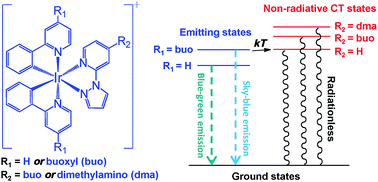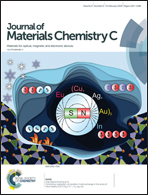Fluorine-free, highly efficient, blue-green and sky-blue-emitting cationic iridium complexes and their use for efficient organic light-emitting diodes†
Abstract
Fluorine-free, highly efficient, blue-green-emitting cationic iridium complexes, [Ir(ppy)2(buo-pzpy)]PF6 (1) and [Ir(ppy)2(dma-pzpy)]PF6 (2), and sky-blue-emitting complexes, [Ir(buo-ppy)2(buo-pzpy)]PF6 (3) and [Ir(buo-ppy)2(dma-pzpy)]PF6 (4), have been designed, synthesized and fully characterized. Here, 2-phenylpyridine (ppy) and 4-butoxy-2-phenylpyridine (buo-ppy) are adopted as the cyclometalating ligands; 4-butoxy-2-(1H-pyrazol-1-yl)pyridine (buo-pzpy) and 4-dimethylamino-2-(1H-pyrazol-1-yl)pyridine (dma-pzpy) are employed as the ancillary ligands. Compared with the conventional 2-(1H-pyrazol-1-yl)pyridine (pzpy) ligand, buo-pzpy and dma-pzpy are able to destabilize the non-radiative charge-transfer (Ir/ppy → pzpy) states away from the emitting triplet states, through destabilizing the lowest unoccupied molecular orbitals residing on the pzpy-type ancillary ligands, which substantially suppresses the non-radiative decays of the emitting triplet states. Moreover, it is experimentally shown that the new ancillary ligands, especially dma-pzpy, promote the radiative decays of the emitting triplet states. With suppressed non-radiative decays and promoted radiative decays, complexes 1–4 afford high luminescent efficiencies and relatively short excited-state lifetimes. Importantly, complex 4 achieves comparable emission color, luminescent efficiency and excited-state lifetime to the archetypal fluorine-containing, blue-emitting, neutral iridium complex FIrpic in the doped films. Single-layer, solution-processed organic light-emitting diodes, which can also be termed organic light-emitting cells (OLECs), have been fabricated. The blue-green OLEC using complex 2 as the dopant affords a current efficiency (ηc) of 22.4 cd A−1, which is nearly doubled compared to that achieved by the counterpart [Ir(ppy)2(pzpy)]PF6. The sky-blue OLEC using complex 4 as the dopant provides an electroluminescence (EL) peak at 476 nm and a current efficiency of 17.2 cd A−1, which rival those [ELpeak = 474 nm, ηc = 15.8 cd A−1] achieved by FIrpic in the same device configuration.



 Please wait while we load your content...
Please wait while we load your content...